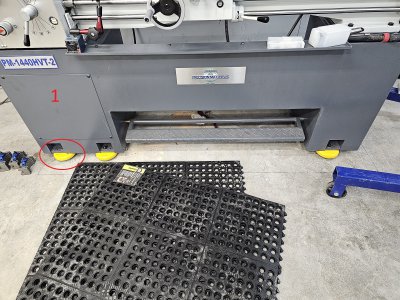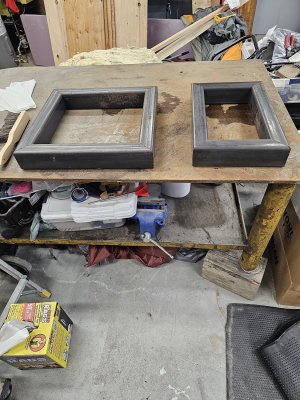I'm building a base for my lathe to get it a bit higher but I'm not sure where I should put the feet. I'm using footmaster GDR80 1100 lb leveling casters and I have 4 of them. Do you guys think I should put them in the circle of pic 1 and add a normal foot next to it or put it in the circle in pic 2 and just have the 4 points of contact. Pic 2 would surely make it easier to level so I'm leaning towards that but wanted to ask some more experienced folk before i start welding it all up.
-
Welcome back Guest! Did you know you can mentor other members here at H-M? If not, please check out our Relaunch of Hobby Machinist Mentoring Program!
You are using an out of date browser. It may not display this or other websites correctly.
You should upgrade or use an alternative browser.
You should upgrade or use an alternative browser.
Lathe base feet position
- Thread starter joeblow65
- Start date
I think I'd want to keep the footprint it already as, with 6 feet on the ground. Were that me, I'd probably be inclined to go with picture 1, as the four leveling casters will surely be adequate while the machine is being moved, but I'd probably make up a couple of simple threaded feet to stick under the where the remaining two original "middle" feet are, that could be ignored during moving, but dropped and used while it's stationary. If the original feet won't be used, maybe just a spacer for a couple of those.
- Joined
- Jan 4, 2021
- Messages
- 1,814
Talk to Precision Mathews, but they wouldn't have provided 4 locations if they didn't think the headstock weight & structure didn't require them. Even the frames you show would change the originally designed dynamic & static loading.
This, all day long!I think I'd want to keep the footprint it already as, with 6 feet on the ground. Were that me, I'd probably be inclined to go with picture 1, as the four leveling casters will surely be adequate while the machine is being moved, but I'd probably make up a couple of simple threaded feet to stick under the where the remaining two original "middle" feet are, that could be ignored during moving, but dropped and used while it's stationary. If the original feet won't be used, maybe just a spacer for a couple of those.
- Joined
- Apr 8, 2013
- Messages
- 1,982
In picture 1 the bed could sag. In picture 2 you have no way of leveling the headstock in relation to the tailstock except leaving it to the bed ways and if they're not perfect there's not much you can do. Go with the factory footprint.
If the bed on a 2k lb Taiwanese lathe is going to sag its not even worth the metal its made from. I'm not sure what you're getting at about the headstock. The headstock is bolted to the bed casting so the only way to level the headstock independently of the bed is with shims.In picture 1 the bed could sag. In picture 2 you have no way of leveling the headstock in relation to the tailstock except leaving it to the bed ways and if they're not perfect there's not much you can do. Go with the factory footprint.
I'm going to go with pic 1 and have a screw foot where the other foot is. Thanks for all the help!
- Joined
- Feb 26, 2021
- Messages
- 473
I'm going to go with pic 1 and have a screw foot where the other foot is. Thanks for all the help!
That seems like a reasonable plan. The main thing is to support that heavy headstock area at four points. I did the same thing with my smaller 12x36, and it feels nice and stable.
- Joined
- Apr 8, 2013
- Messages
- 1,982
If a lathe bed could not twist or sag you wouldn't need leveling feet at at all. Suit yourself, sir.If the bed on a 2k lb Taiwanese lathe is going to sag its not even worth the metal its made from. I'm not sure what you're getting at about the headstock. The headstock is bolted to the bed casting so the only way to level the headstock independently of the bed is with shims.
I'm going to go with pic 1 and have a screw foot where the other foot is. Thanks for all the help!
Last edited:
- Joined
- Oct 11, 2016
- Messages
- 3,866
@joeblow65 The lathe bed on my 3800 lb LeBlond lathe twists easily, as does the bed on Top Lipton's 6500 lb TOS lathe. Do what you want, but your are losing all the accuracy of your lathe. The headstock needs 4 feet for a lathe of that type and size. you are re-engineering the lathe without the benefit of drawing the force diagramme or doing an FEA.
Machinists fix this problem all the time. We make 6 pucks, usually from solid steel, to one each under each foot. It has nothing to do with strength of your casters. Strength does not equal rigidity.
If you *want* a mobile base, that is an entirely different thing. A very long discussion.
Machinists fix this problem all the time. We make 6 pucks, usually from solid steel, to one each under each foot. It has nothing to do with strength of your casters. Strength does not equal rigidity.
If you *want* a mobile base, that is an entirely different thing. A very long discussion.
Last edited:




